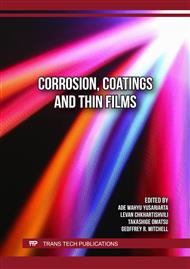[1]
R.B. Bergmann, J.H. Werner, The future of crystalline silicon films on foreign substrates, Thin Solid Films, 403/404 (2002) 162-169.
DOI: 10.1016/s0040-6090(01)01556-5
Google Scholar
[2]
G. Korotcenkov, Thin metal films, in: Handbook of Gas Sensor Materials: Properties, Advantages and Shortcomings for Applications, Vol. 1: Conventional Approaches, Integrated Analytical Systems, Springer, New York (2013) Ch. 4, 153-166.
DOI: 10.1007/978-1-4614-7165-3_4
Google Scholar
[3]
J.E. Greene, Review Article: Tracing the recorded history of thin-film sputter deposition: From the 1800s to 2017, J. Vac. Sci. Technol. A 35 (2017) 05C204 (1-60).
DOI: 10.1116/1.4998940
Google Scholar
[4]
H. Nagai, M. Sato, Molecular precursor method for fabricating p-type Cu2O and metallic Cu thin films, in: Modern Technologies for Creating the Thin-film Systems and Coatings, N.N. Nikitenkov (ed.), IntechOpen (2017) Ch. 1, 3-20.
DOI: 10.5772/66476
Google Scholar
[5]
M. Benelmekki, A. Erbe, Chapter 1 – Nanostructured thin films – Background, preparation and relation to the technological revolution of the 21st century, Front. Nanosci. 14 (2019) 1-34.
DOI: 10.1016/b978-0-08-102572-7.00001-5
Google Scholar
[6]
S. Kumar, D.K. Aswal, Thin film and significance of its thickness, in: Recent Advances in Thin Films, S. Kumar, D.K. Aswal (eds.), Springer, Singapore (2020) 1-12.
DOI: 10.1007/978-981-15-6116-0_1
Google Scholar
[7]
Ph.N. Hishimone, H. Nagai, M. Sato, Methods of fabricating thin films for energy materials and devices, in: Lithium-Ion Batteries – Thin Film for Energy Materials and Devices, M. Sato, L. Lu, H. Nagai (eds.), IntechOpen (2020) Ch. 2, 1-21.
DOI: 10.5772/intechopen.85912
Google Scholar
[8]
M.I. Hossain and S.A. Mansour, Critical overview of thin films coating technologies for energy applications, Cogent Eng. 10 (2023) 2179467 (1-18).
DOI: 10.1080/23311916.2023.2179467
Google Scholar
[9]
Z. Benzarti, A. Khalfallah, Recent Advances in the development of thin films, Coatings 14 (2024) 878 (1-4).
DOI: 10.3390/coatings14070878
Google Scholar
[10]
A.R. Smith, M. Ghamari, S. Velusamy, S. Sundaram, Thin-film technologies for sustainable building-integrated photovoltaics, Energies 17 (2024) 6363 (1-39).
DOI: 10.3390/en17246363
Google Scholar
[11]
K. Ishraque, N.M. Ashikul Haque, A. Ahmed, S. Md. Abdus, A. Aninda, Effect of silver and cobalt on transparent conducting CdO thin films: Tuning the optoelectronic properties, Mater. Adv. 6 (2024) 703-718.
DOI: 10.1039/d4ma00918e/v2/response1
Google Scholar
[12]
P.J. Perez–Diaz, Y. Esqueda–Barron, J.M. Baas–Lopez, A.K. Cuentas–Gallegos, D.E. Pacheco–Catalan, Synthesis of manganese oxide thin films deposited on different substrates via atmospheric pressure-CVD, Surf. Coat. Technol., 494-2 (2024) 131440 (1-5).
DOI: 10.1016/j.surfcoat.2024.131440
Google Scholar
[13]
F.T. Mahi, K. Nakajima, Liquid phase epitaxy, Ref. Module Mater. Sci. Mater. Eng. https://doi.org/10.1016/B978-0-12-803581-8.03677-8 (2016) 1-10.
Google Scholar
[14]
H. Sitter, A. Andreev, G. Matt, N.S. Sariciftci, Hot-wall-epitaxy – The method of choice for the growth of highly ordered organic epilayers, Mol. Cryst. Liquid Cryst. 385 (2002) 51-60.
DOI: 10.1080/713738791
Google Scholar
[15]
M.C. Rao, M.S. Shekhawat, A brief survey on basic properties of thin films for device application, Int. J. Mod. Phys. Conf. Ser. 22 (2013) 576-582.
DOI: 10.1142/s2010194513010696
Google Scholar
[16]
K. Bourzac, Japan gambles on displays, Nature 484 (2012) 301-301.
DOI: 10.1038/484301a
Google Scholar
[17]
K. Mukhopadhyay, A.K. Chakroborty, A.P. Chatterjee, S.K. Lahiri, Galvanostatic deposition and electrical characterization of cuprous oxide thin films, Thin Solid Films 209 (1992) 92-96.
DOI: 10.1016/0040-6090(92)90015-4
Google Scholar
[18]
K.P. Muthe, J.C. Vyas, S.N. Narang, D.K. Aswal, S.K. Gupta, D. Bhattacharya, R. Pinto, G.P. Kothiyal, S.B. Sabharwal, A study of the CuO phase formation during thin film deposition by molecular beam epitaxy, Thin Solid Films 324 (1998) 37-43.
DOI: 10.1016/s0040-6090(97)01203-0
Google Scholar
[19]
S. Izhizuka, S. Kato, T. Maruyama, K. Akimoto, Nitrogen doping into Cu2O thin films deposited by reactive radio-frequency magnetron sputtering, Japanese J. Appl. Phys. 40 (2001) 2765-2768.
DOI: 10.1143/jjap.40.2765
Google Scholar
[20]
S. Joseph, P.V. Kamath, Electrochemical deposition of Cu2O on stainless steel substrates: Promotion and suppression of oriented crystallization, Solid State Sci. 10 (2008) 1215-1221.
DOI: 10.1016/j.solidstatesciences.2007.11.007
Google Scholar
[21]
E. Khutsishvili, T. Qamushadze, G. Goderdzishvili, Silicon from Rocks to Electronics, Favorite Style, Tbilisi (2023).
Google Scholar
[22]
F.A. Trumbore, Solid solubilities of impurity elements in germanium and silicon, Bell Syst. Tech. J., 39 (1960) 205-233.
DOI: 10.1002/j.1538-7305.1960.tb03928.x
Google Scholar
[23]
R.W. Olesinki, N. Kanani, G.J. Abbaschian, The Ge–In (germanium–indium) system, Bull. Alloy Phase Diag. 6 (1985) 536-539.
DOI: 10.1007/bf02887153
Google Scholar
[24]
A. Sato, K. Suzuki, H. Horie, T. Sugii, Determination of solid solubility limit of In and Sb in Si using bonded silicon-on-insulator (SoI) substrate, in: Proc. IEEE Int. Conf. Microelectr. Test Str., 8 (1995) 259-263.
DOI: 10.1109/icmts.1995.513984
Google Scholar


